-
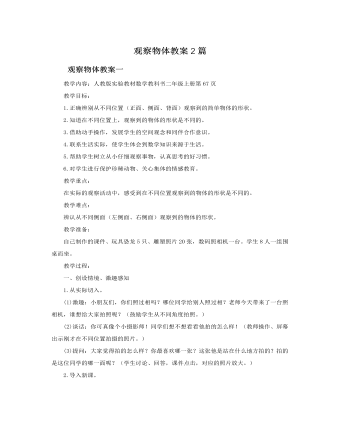
人教版新课标小学数学二年级上册观察物体教案2篇
教学过程:一、故事导入1.出示主题图配合音乐,师:“有一只蜻蜓在动物城里玩,遇到了辛勤工作的蜜蜂,看见了一座座漂亮的房屋。”蝴蝶说:“瞧。自己做了一件衣服,但是穿起来很不合身,怎么办?”(出现三种不对称的衣服图形)“于是,蝴蝶去找蜻蜓帮忙。”2.师:“一路上,蝴蝶看到许多美丽的景色,遇见许多动物朋友。瞧,美丽的孔雀走来了,还有知了、七星瓢虫、螃蟹。”3.师:“小朋友,它们美吗?你能说说你觉得它们哪儿美?(学生自由回答)那咱们把它们画下来,好吗?”二、初步感知对称图形的特点1.(指着蝴蝶形)师:“这么美的图形你想不想剪出一个来?请小朋友们拿出一张彩纸,用剪刀剪出这只蝴蝶,行吗?”(请学生说一说怎么剪的?)师:“有的小朋友剪出的蝴蝶为什么不像呢?为什么有的小朋友又能剪出美丽的蝴蝶呢?蝴蝶的形状到底有什么特点,让咱们来研究研究。”

人教版新课标小学数学二年级上册两位数加、减两位数的应用题教案
1、试验性操作实验师:大家说红花的照片能不能用方格代表?下面请同学们用方格代表红花的照片,用我们的学具卡片摆出红花的朵数。(学生操作,教师巡视。)师:大家说黄花的朵数能不能也可以这样操作出?请同学们用上面的方法再操作出黄花的朵数。(学生操作)师:同学们已经摆出了红花的朵数和黄花的朵数,怎么操作才能知道红花和黄花一共是多少朵?(把红花的朵数和黄花的朵数合并起来数一数)(学生操作,教师巡视。)师:请把合并起来的数整理一下,让人一看就能知道是多少朵好吗?请同学们写出算式的答案。(即操作表达式)教师多媒体演示全部操作实验过程,并简单小结。2、验证性操作实验师:同学们,假如红花是56朵,黄花是38朵,求“红花和黄花共几朵?”你们还能不能用上面的操作实验方法来解决?(能)好!那就请你们试试看。(学生操作,教师巡视。)
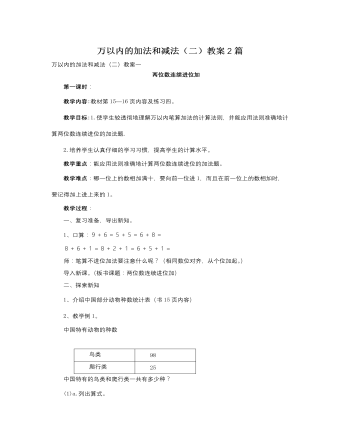
人教版新课标小学数学三年级上册万以内的加法和减法(二)教案2篇
●教学内容:教科书第27页的内容。●教学目标:①通过创设具体的情境,使学生初步学会加法的验算,并通过加法验算方法的交流、让学生体会算法的多样化。②培养学生探索合作交流的意识和能力。③让学生用所学到的验算知识去解决生活中的问题,体会用数学的乐趣。●教具准备:老师准备挂图或课件。●教学过程:创设情境、导入新课。师:同学们,你们与爸爸、妈妈去超市买过东西吗?生:互相说说,再请同学发表意见。师:(挂图1)我们来看挂图,小明和妈妈去超市买东西,从图1中你看到了什么?生1:从图1中我看到了小明妈妈买了一套135元的运动服和一双48元的运动鞋。生2:从图1中我看到小明妈妈给了售货员200元。生3:要知道一套运动服和一双运动鞋一共要多少元?应用加法计算。师:全班动手计算。板书:135+48=183(元)
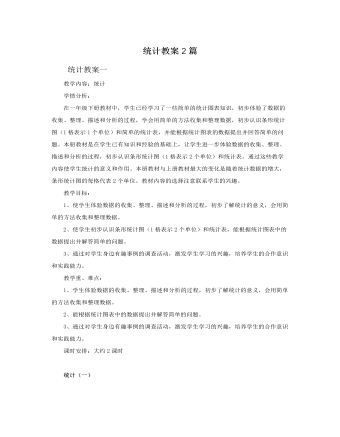
人教版新课标小学数学二年级上册统计教案2篇
1、让学生仔细观察,练习二十二1题图,你看到了什么?生:举手自由口答。2、师:根据这些信息,你能提出什么问题?板书学生提出问题在此基础上,师生重点解决问题3、小黑板出数统计表、统计图(1)学生在树上独立完成(2)上台展示并回答问题(3)师质疑:你还能提出哪些问题?[设计意图]:通过统计停车场每种车的数量,把解决问题和统计知识综合进来,巩固所学统计知识和解决问题,体验怎样收集信息。二、生活应用1、出示97页2题(1)同桌观察理解(2)独立在书上完成2、互相纠错评价,教师巡视辅导。3、质疑:你还能提出什么问题?[设计意图]:让学生通过数“正”字来收集信息。三、开放实践1、p97页3题4题(1)学生以小组为单位展开讨论统计。(1、2、3组做3题,4、5、6组做4题)(2)展示师生互评[设计意图]:让学生发挥主体性去调查收集数据,根据自己的能力提出并回答一些问题。

人教版新课标小学数学二年级上册角的初步认识教案2篇
【课中安排学唱《可爱的角》这首歌曲,旋律是学生熟悉并喜爱的,加上简明扼要的歌词和动作,提高了孩子们的兴趣。】四、课堂活动(课件出示)1.辨角。用你火眼金睛找出哪些是角?哪些不是角?为什么?(练习八的第1题)【在学生对角建立起概念的前提下,让学生做该练习,从而加深了学生对角的认识,增强分析、判断能力。这个练习可以叫它“跟随”练习,即刚学会一个新的概念,认识一个新的内容之后,紧跟着的一个比较容易的以选择和判断为主的练习。】2.数角(练习八的第2题)。师:小马看见小朋友们都认识了角,非常高兴,看看天色不早了,赶紧赶路,跑了一会儿,看见图形王国里面有许多图形,但小马不知道各有几个角?小朋友们能帮助它数一数吗?【这是一道“巩固”练习,让学生将所学知识做一次运用,难度稍加大,但学生能做出来,并且能找到练习中的规律,能享受到一种成就感。】
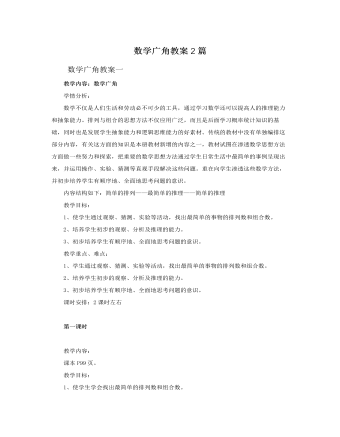
人教版新课标小学数学二年级上册数学广角教案2篇
方法三:我先把数字1放在个位,然后把数字2和3分别放在十位组成21和31;我再把数字2放在个位,然后把数字1和3分别放在十位组成12和32;我再把数字3放在个位,然后把数字1和2分别放在十位组成13和23,一共摆出了6个两位数。(21、31、12、32、13、23)每种方法说完后师问:还能摆吗?(再摆就要重复了!提示:不能遗漏也不能重复)师小结:排数的时候按照一定的顺序既不会重复也不会遗漏。我们用3个不同的一位数拼成了几个不同的两位数?(板书:6个)可拓展:三只动物抽到卡片后最多能组成21、31、32那谁可以和聪聪一起坐呀?小猫很幸运,他抽到了2和3,那么他一定会摆出一个……(三)握手小动物们谢谢我们帮他们一起解决了这些数学问题,一定要让老师表示谢意,好谢谢你们。(老师过去和学生握手。分别找几个人握手,让学生观察,每两个人握一次手。)
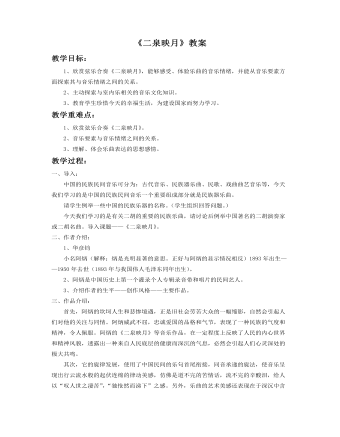
《二泉映月》教案
首先,阿炳的坎坷人生和悲惨境遇,正是旧社会劳苦大众的一幅缩影,自然会引起人们对他的关注与同情。阿炳威武不屈,忠诚爱国的品格和气节,表现了一种民族的气度和精神,令人佩服。阿炳的《二泉映月》等音乐作品,在一定程度上反映了人民的内心世界和精神风貌,透露出一种来自人民底层的健康而深沉的气息,必然会引起人们心灵深处的极大共鸣。 其次,它的旋律发展,使用了中国民间的乐句首尾衔接,同音承递的旋法,使音乐呈现出行云流水般的起伏连绵的律动美感,仿佛是道不完的苦情话,流不完的辛酸泪,给人以“叹人世之凄苦”,“独怆然而涕下”之感。另外,乐曲的艺术美感还表现在于深沉中含质朴,感伤中见苍劲,刚柔并济,动人心魄。再则,这首乐曲体现了注重情深、着意传神的法则,发人联想,令人回味。
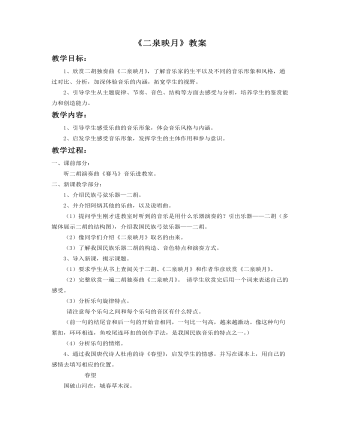
《二泉映月》教案
教学过程:一、课前部分: 听二胡演奏曲《赛马》音乐进教室。二、新课教学部分: 1、介绍民族弓弦乐器—二胡。 2、并介绍阿炳其他的乐曲,以及说唱曲。 (1)提问学生刚才进教室时听到的音乐是用什么乐器演奏的?引出乐器——二胡(多媒体展示二胡的结构图),介绍我国民族弓弦乐器——二胡。 (2)像同学们介绍《二泉映月》取名的由来。 (3)了解我国民族乐器二胡的构造、音色特点和演奏方式。 3、导入新课,揭示课题。 (1)要求学生从书上查阅关于二胡、《二泉映月》和作者华彦欣赏《二泉映月》。 (2)完整欣赏一遍二胡独奏曲《二泉映月》。 请学生欣赏完后用一个词来表述自己的感受。
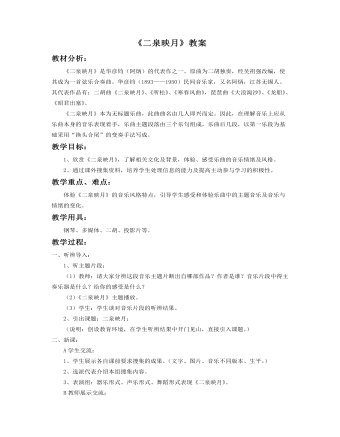
《二泉映月》教案
教材分析: 《二泉映月》是华彦钧(阿炳)的代表作之一。原曲为二胡独奏,经吴祖强改编,使其成为一首弦乐合奏曲。华彦钧(1893——1950)民间音乐家,又名阿炳,江苏无锡人。其代表作品有:二胡曲《二泉映月》、《听松》、《寒春风曲》,琵琶曲《大浪淘沙》、《龙船》、《昭君出塞》。 《二泉映月》本为无标题乐曲,此曲曲名由几人即兴而定。因此,在理解音乐上应从乐曲本身的音乐表现着手,乐曲主题段落由三个乐句组成,乐曲后几段,以第一乐段为基础采用“换头合尾”的变奏手法写成。教学目标: 1、欣赏《二泉映月》,了解相关文化及背景,体验、感受乐曲的音乐情绪及风格。 2、通过课外搜集资料,培养学生处理信息的能力及提高主动参与学习的积极性。
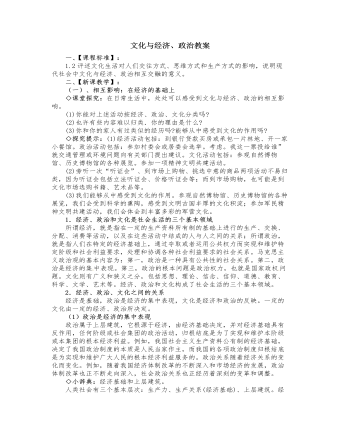
人教版高中政治必修3文化与经济、政治教案
另一方面,文化素质影响公民政治权利的行使。随着民主和法制建设的发展,人们为了参与政治生活,需要更高的文化素养。文化水平提高了,人们受到的教育、接受的信息就越多,活动的领域就越广,民主法制和权利意识就越强,这些都会影响人们的民主素质和民主水平,使人们更好地进行政治参与,行使民主权利。(2)文化与国际政治相互交融,成为当代国际政治斗争的重要内容。随着世界多极化的发展,奉行霸权主义的国家,借助文化渗透的方式,竭力推销自己的价值观念,企图削弱和取代别国的民族文化,以推行强权政治。这使世界范围内反对文化霸权主义的斗争,成为当代国际政治斗争的重要内容。文化已经成为进行政治斗争、国际斗争的重要形式之一。对文化市场的争夺不仅仅是争夺票房价值、争夺经济效益,更主要的是对受众对象的争夺,对受众注意力这种特殊的稀缺资源的占有,以及在此基础上对舆论的控制与引导。因此,失去文化市场就意味着失去政治优势,意味着政治影响力的边缘化乃至萎缩或丧失。这一点,从目前世界正在进行的空前规模的“文化战争”,可以看得非常清楚。
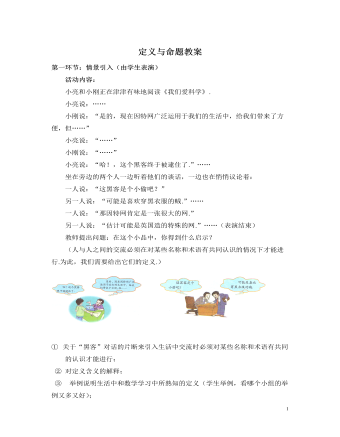
北师大初中数学八年级上册定义与命题2教案
② 命题的含义:判断一件事情的句子,叫做命题,如果一个句子没有对某一件事情作出任何判断,那么它就不是命题.活动目的:通过课后的总结,使学生对定义、命题等概念有更清楚的认识,让学生在头脑中对本节课进行系统的归纳与整理.教学效果:学生在有了前面对定义、特别是命题概念的学习后,能了解命题的结构,以及哪些是命题,使学生对命题的学习有了清楚的认识。第五环节 课后练习学习小组搜集八年级数学课本中的新学的部分定义、命题,看谁找得多.四、教学反思本节课的设计具有如下特点:(1)采用了“小品表演”的形式引入新课,意在激起学生对数学的兴趣,让学生知道,数学不是枯燥无味的。并能从表演中不同的人对“黑客”这个名词的不同理解更好地悟出“定义”的含义。
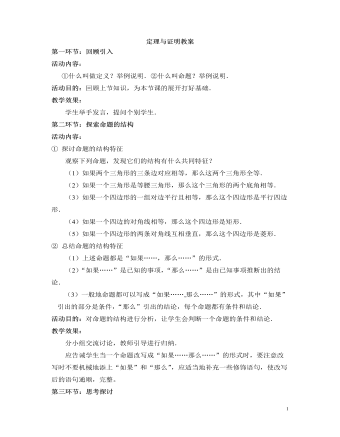
北师大初中数学八年级上册定理与证明2教案
第一环节:回顾引入活动内容:①什么叫做定义?举例说明.②什么叫命题?举例说明. 活动目的:回顾上节知识,为本节课的展开打好基础.教学效果:学生举手发言,提问个别学生.第二环节:探索命题的结构活动内容:① 探讨命题的结构特征观察下列命题,发现它们的结构有什么共同特征?(1)如果两个三角形的三条边对应相等,那么这两个三角形全等.(2)如果一个三角形是等腰三角形,那么这个三角形的两个底角相等.(3)如果一个四边形的一组对边平行且相等,那么这个四边形是平行四边形.(4)如果一个四边的对角线相等,那么这个四边形是矩形.(5)如果一个四边形的两条对角线互相垂直,那么这个四边形是菱形.② 总结命题的结构特征(1)上述命题都是“如果……,那么……”的形式.(2)“如果……”是已知的事项,“那么……”是由已知事项推断出的结论.
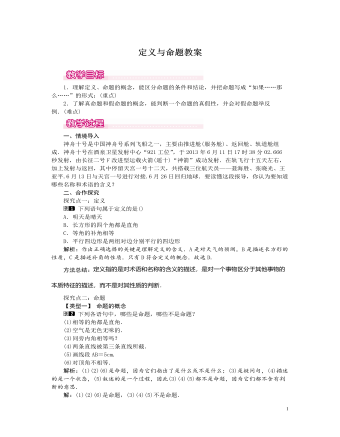
北师大初中数学八年级上册定义与命题1教案
一、情境导入神舟十号是中国神舟号系列飞船之一,主要由推进舱(服务舱)、返回舱、轨道舱组成.神舟十号在酒泉卫星发射中心“921工位”,于2013年6月11日17时38分02.666秒发射,由长征二号F改进型运载火箭(遥十)“神箭”成功发射.在轨飞行十五天左右,加上发射与返回,其中停留天宫一号十二天,共搭载三位航天员——聂海胜、张晓光、王亚平.6月13日与天宫一号进行对接.6月26日回归地球.要读懂这段报导,你认为要知道哪些名称和术语的含义?二、合作探究探究点一:定义 下列语句属于定义的是()A.明天是晴天B.长方形的四个角都是直角C.等角的补角相等D.平行四边形是两组对边分别平行的四边形解析:作出正确选择的关键是理解定义的含义.A是对天气的预测,B是描述长方形的性质,C是描述补角的性质.只有D符合定义的概念.故选D.方法总结:定义指的是对术语和名称的含义的描述,是对一个事物区分于其他事物的本质特征的描述,而不是对其性质的判断.
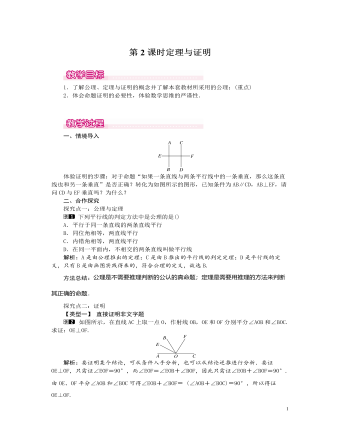
北师大初中数学八年级上册定理与证明1教案
求证:直角三角形的两个锐角互余.解析:分析这个命题的条件和结论,根据已知条件和结论画出图形,写出已知、求证,并写出证明过程.已知:如图所示,在△ABC中,∠C=90°.求证:∠A与∠B互余.证明:∵∠A+∠B+∠C=180°(三角形内角和等于180°),又∠C=90°,∴∠A+∠B=180°-∠C=90°.∴∠A与∠B互余.方法总结:解此类题首先根据题意将文字语言变成符号语言,画出图形,最后再经过分析论证,并写出证明的过程.三、板书设计命题分类公理:公认的真命题定理:经过证明的真命题证明:推理的过程经历实际情境,初步体会公理化思想和方法,了解本教材所采用的公理,让学生对真假命题有一个清楚的认识,从而进一步了解定理、公理的概念.培养学生的语言表达能力.

新人教版高中英语必修2Unit 1 Cultural Heritage-Discovering Useful Structure教案二
This theme of the part is “ Describe people or things in greater detail”. Students have learned the grammar(restrictive relative clauses) in Book 1, and further review and consolidate its structure “prep+relative pronouns(which/whom)” and the relative adverbs(when, where and why), besides students should understand its form, meaning and functions. In this section, students should be able to express the grammar correctly in daily communication and in the writing. 1. Review the basic usages of relative pronouns and adverbs of attributive clauses . 2. Learn to use some special cases about restrictive relative clauses.3. Learn to write sentences with restrictive relative clauses flexibly according to the context.1. Review the basic usages of relative pronouns and adverbs of attributive clauses .2. Learn to use some special cases about restrictive relative clauses.3. Learn tow rite sentences with restrictive relative clauses flexibly according to the context.Step 1. Observe the following sentences, and mark the relative pronouns and the adverbs. 1. After listening to the scientists who had studied the problems, and citizens who lived near the dam, the government turned to the United Nations for help.2. Temples and other cultural sites were taken down piece by piece, and then moved and put back together again in a place where they were safe from the water.Step 2 PracticePlease complete these sentences with relative pronouns and relative adverbs and answer the following questions.Questions: 1. What is the head noun ?2. What relative words should be used ?3. What elements do they act in these sentences ?

新人教版高中英语必修2Unit 2 Wildlife Protection-Reading for Writing教案二
This lesson aims at making a poster about protecting wildlife after reading some posters. During reading students are guided to understand the content and try to summarize the posters with one sentence. Then students are guided to try to make a poster about protecting wildlife.1. Read the two posters and try to understand the summary sentences.2. Look at the two posters and try to understand what emotions they express.3. Try to summarize the features of posters4. Try to make a poster about wildlife.1. Look at the two posters and try to understand what emotions they express.2. Try to summarize the features of posters3. Try to make a poster about wildlife.Step 1 Lead inLook at the the posters on the textbook and ask:Which emotions do the posters communicate ?Step 2 Read the poster and answer the questions.1. What do you think of the animals in the poster on the left ?I think it is frightening and ugly.2. Why do we should protect the ugly animals ?All species--the good, the bad, and the ugly-- should be treated equally.The world needs all kinds--without variety, our planet cannot survive.3. Why are billions of trees being cut down every year ?To make paper for humans.4. What result will be lead to after the trees are cut down ?A lost of animal homes are being destroyed./The habitat of wildlife is being destroyed.Step 3 Find the feature of posters1. What does each poster use to stir up emotions ?On the left, it makes us a little frightened and it looks a little ugly, but it can activate our curiosity--What is it? And What is wrong with it?On the right, it makes us feel a little sad and want to protect them.

新人教版高中英语必修2Unit 1 Cultural Heritage-Reading and Thinking教案二
1. This section focuses on "Understanding how a problem was solved”, which is aimed to guide students to analyze and discuss the challenges and problems faced by cultural heritage protection during the construction of Aswan Dam, as well as the solutions. On the basis of understanding, students should pay attention to the key role of international cooperation in solving problems, and attach importance to the balance and coordination between cultural heritage protection and social and economic development. Students are encouraged to face challenges actively, be good at cooperation, and make continuous efforts to find reasonable ways and means to solve problems.2. Enable students to understand the main information and text structure of the reading text;3. Motivate students to use the reading strategy "make a timeline" according to the appropriate text genre;4. Enable students to understand how a problem was solved;5. Enable students to understand the value of protecting cultural heritage by teamwork and global community;1. Guide students to pay attention to reading strategies, such as prediction, self-questioning and scanning.2. Help students sort out the topic language about protecting cultural relics and understand the narrative characteristics of "time-event" in illustrative style3. Lead students to understand the value of protecting cultural heritage by teamwork and global community;

新人教版高中英语必修2Unit 2 Wildlife Protection-Discovering Useful Structure教案二
2.表示现阶段正在进行的被动动作(该动作在说话的瞬间未必正在进行)。Many interesting experiments are being carried out these days.(说话时,并不一定正在进行)3.表示一种经常性的被动行为,常和always,constantly 等表示频度的副词连用,这种用法常常带有赞扬或厌恶的感情色彩。He is always being praised by the leader.4.表示按计划或安排主语将要承受谓语动词所表示的动作(仅限于少数及物动词)。A party is being held tonight.Step 4 Special cases1.像take care of, look after, talk about, think of等动词与介词构成的短语用于现在进行时的被动语态时, 其中的介词不可省略。The ways to stop illegally hunting are being talked about. 2.可与部分情态动词连用,表示对正在发生的事情的推测。She may be being punished by her mother.3.有时可表示按计划或安排将要进行的一个被动动作。A celebration is being held this weekend for his success.4.某些表示“状态、心理活动、存在”等的动词,如have,want,need,love,一般不用现在进行时的被动语态,而常用一般现在时的被动语态。With the population increasing,more land is needed.5.“be+under/in+n.”可表示现在进行时的被动意义。My computer is under repair.=My computer is being repaired.

新人教版高中英语必修2Unit 2 Wildlife Protection-Reading and Thinking教案二
The theme of this unit is human and nature, focusing on the theme of wildlife protection. Nature is a complex ecosystem, in which there are delicate balance between animals and plants. Because of the role of the food chain, the extinction of one species will produce influence, causing a series of chain reaction. Large scale extinction of species will have a serious and even irreversible impact on the ecosystem, resulting in immeasurable losses. Therefore, it is of great significance to protect wild species. To protect wild species is to protect human beings themselves. The motto of this unit is "when the buying stops, the killing can too,” which is a public service advertising slogan to protect wildlife. It tells people that every rhinoceros horn, every fur, every bowl of shark fin soup, every Ivory product, and every tiger bone product, etc. consumed by human beings, are innocent wild animals slaughtered behind them. The mission of wild aid is to ban illegal trade in endangered wildlife and mitigate climate change. It aims to educate the public to reduce the consumption demand for endangered wildlife products through public publicity and improve the awareness of environmental protection.1. Improve the awareness of wildlife protection by acquiring the knowledge of wildlife protection.2. Focus on environmental protection and protection of all lives.3. Analysis of the living environment of wild animals with appropriate thinking mode.4. Skillfully use the vocabulary and grammar knowledge of this unit to cultivate self-study ability according to the unit content5. Develop cooperative learning ability through discussion and other ways1. Enable the Ss to talk about the current situation of wild animals.2. Guide the Ss to summarize the main idea of each paragraph as well as the main idea of the text.

新人教版高中英语必修2Unit 3 The Internet-Discovering Useful Structure教案二
This teaching period mainly deals with grammar “The Present Perfect Passive Voice.” To begin with, teachers should lead students to revise what they have learned about the Present Perfect Passive Voice. And then, teachers move on to stress more special cases concerning this grammar。This period carries considerable significance to the cultivation of students’ writing competence and lays a solid foundation for the basic appreciation of language beauty. The teacher is expected to enable students to master this period thoroughly and consolidate the knowledge by doing some exercises. 1. Guide students to review the basic usages of the Present Perfect Passive Voice2. Lead students to learn to use some special cases concerning the Present Perfect Passive Voice flexibly.2. Enable students to use the basic phrases structures flexibly.3. Strengthen students’ great interest in grammar learning.1. Help students to appreciate the function of the Present Perfect Passive Voice in a sentence2. Instruct students to write essays using the proper the Present Perfect Passive Voice.观察下列句子特点,总结共同点。1.(教材P28)Much has been written about the wonders of the World Wide Web.2.(教材P28)But the Internet has done much more for people than simply make life more convenient.3.(教材P28)Many people have been helped by the club.4.(教材P28)She no longer feels lonely, and her company has become quite successful.5.(教材P32)Today I thought I’d blog about a question that has been asked many times—how do you stay safe online and avoid bad experiences on the Internet?

